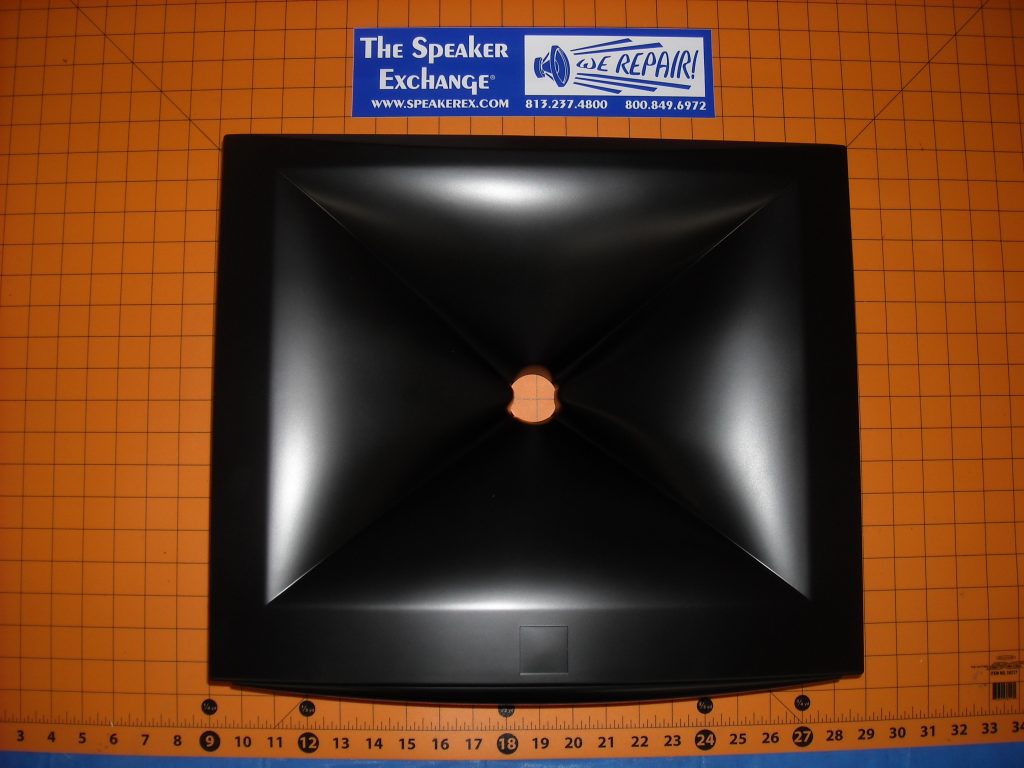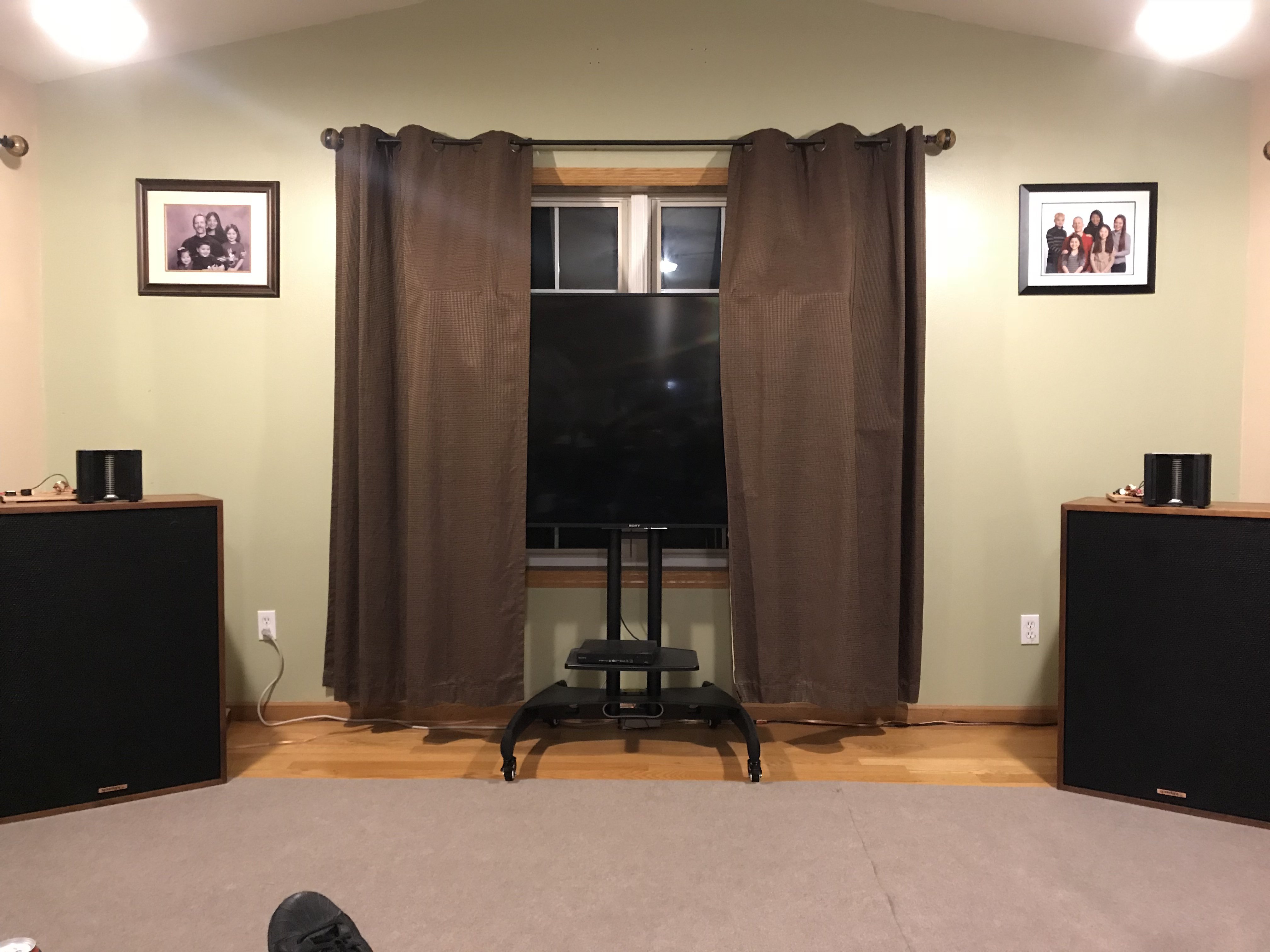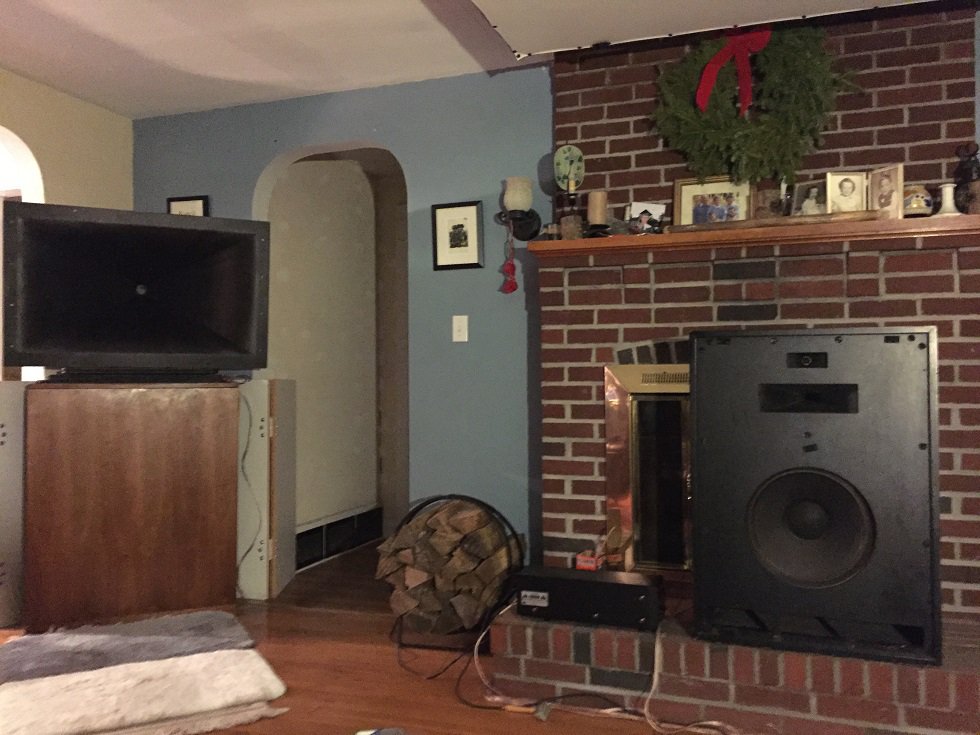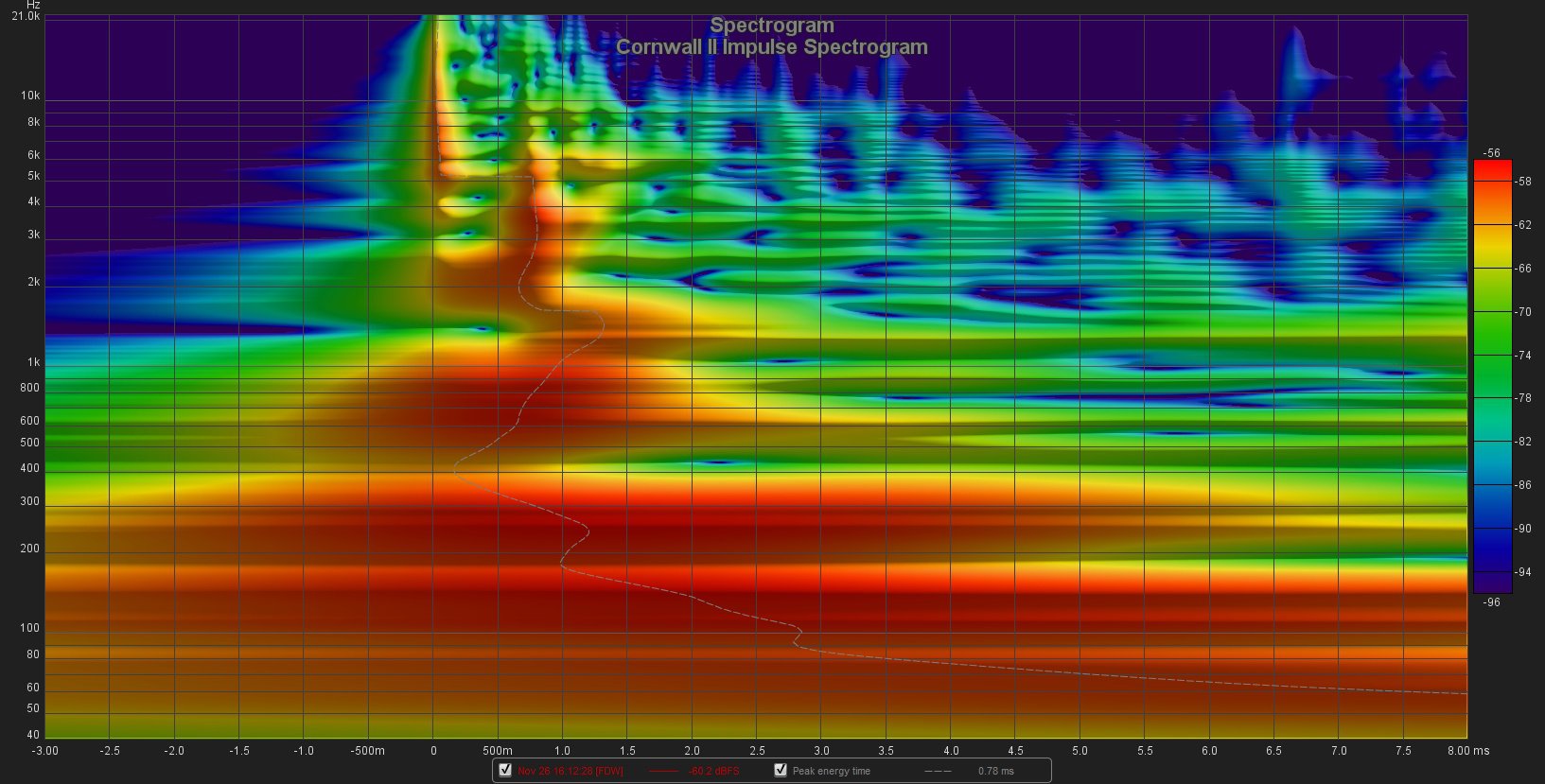I've been listening to my Speakerlab K horn speakers for nearly 10 years now. I paid $600 for them, and in hind sight they are totally worth it. With a bit EQ, they sound pretty good. Actually, they sound much better than I expected, and beat pretty much all other speaker projects I’ve tried in the last 10 years. For instance, last weekend I was playing with a pair of JBL LSR305 speakers augmented by two bass modules, and I was quite impressed by what I heard. But when I switched to the Speakerlab K speakers, I realized that the K's sounded cleaner, with layers of details that the 305's seemed to gloss over, and a much more believable sound space to boot.
I initially did not have high expectations for the K speakers, however, partly because of the odd positioning of the tweeter horn. Instead of being directly above the mid horn, the tweeter horn is (1) rotated 90 degrees so that the width is along the vertical direction, and (2) located to the side of the mid horn mouth. Seeing the huge horizontal offset and also the complete disregard of alignment of horn throats of the tweeter and mid horns, I’m at a loss as to why the speaker could sound good at all. In real life, however, the K speakers present a vivid sound space with fine details, making listening to music with well-captured reverbs quite a treat. For instance, the presentation of the acoustic space of Gregorian chants by the K speakers puts all other speakers I’ve tried in the same room to shame. The nagging question for me is: how come? The good sound I got does not make sense to me. With the tweeter horn physically offset from the mid horn throat by multiple wavelengths at the crossover frequency and also way off the mid horn axis, shouldn’t the integration between the mid and tweeter horns be rather screwed up?
The related question is whether I should try to “improve” the K speakers by relocating the tweeter horns so that they are directly above the mid horns and also moved back to be physically aligned with the mid horn throats. What I have in mind is something like the top half of the JBL K2 speakers, the look of which I quite like. I can also use a DSP to fine tune the time alignment and perhaps redo the crossover. Theoretically the modification should make the speakers sound better. Such a modification, however, would require the removal of the hood part of the housing above the bass horn, and I am kind of reluctant to destroy the speaker housing as it is nicely veneered. I am also not sure whether the modified speakers would really sound noticeably better, as the K speakers already sound pretty fine now, even though I don’t quite understand why they sound as good as they do.
Should I do the modification, or should I just leave well enough alone?
I initially did not have high expectations for the K speakers, however, partly because of the odd positioning of the tweeter horn. Instead of being directly above the mid horn, the tweeter horn is (1) rotated 90 degrees so that the width is along the vertical direction, and (2) located to the side of the mid horn mouth. Seeing the huge horizontal offset and also the complete disregard of alignment of horn throats of the tweeter and mid horns, I’m at a loss as to why the speaker could sound good at all. In real life, however, the K speakers present a vivid sound space with fine details, making listening to music with well-captured reverbs quite a treat. For instance, the presentation of the acoustic space of Gregorian chants by the K speakers puts all other speakers I’ve tried in the same room to shame. The nagging question for me is: how come? The good sound I got does not make sense to me. With the tweeter horn physically offset from the mid horn throat by multiple wavelengths at the crossover frequency and also way off the mid horn axis, shouldn’t the integration between the mid and tweeter horns be rather screwed up?
The related question is whether I should try to “improve” the K speakers by relocating the tweeter horns so that they are directly above the mid horns and also moved back to be physically aligned with the mid horn throats. What I have in mind is something like the top half of the JBL K2 speakers, the look of which I quite like. I can also use a DSP to fine tune the time alignment and perhaps redo the crossover. Theoretically the modification should make the speakers sound better. Such a modification, however, would require the removal of the hood part of the housing above the bass horn, and I am kind of reluctant to destroy the speaker housing as it is nicely veneered. I am also not sure whether the modified speakers would really sound noticeably better, as the K speakers already sound pretty fine now, even though I don’t quite understand why they sound as good as they do.
Should I do the modification, or should I just leave well enough alone?
I’d worry more about the low frequency to mid range time delay différence before I’d worry about the tweeter
I’d worry more about the low frequency to mid range time delay différence before I’d worry about the tweeter
Indeed, the long delay between the bass from bass horn and the mid from the mid horn is part of the mystery of why fully horn-loaded speakers like Klipschorns or the Edgarhorns by Dr. Bruce Edgar would work. Nevertheless, I have not sensed a serious problem caused by such a delay. These speakers are still better in playing percussion music than any small speakers I've heard. It is almost like a joke to compare these speakers with a pair of speakers with puny 8" woofers. Here the ability to move a lot of air matters. Only the big system I had at one time with four 18" woofers in OB on each side is comparable.
The throat distance and horizontal offset between the mid horn and the tweeter horn, however, should (?) cause more noticeable problems, as the crossover frequency is not that high (~4.5K?). Many speaker builders spent a lot time designing two-way or three-way dome-and-cone systems with a crossover around that frequency, and it would be nearly unthinkable for them to intentionally put a tweeter way off axis with a multi-wavelength offset in sound path length from the midrange or mid-bass. I wonder if anyone has seen a dome-and-cone speaker with the tweeter 12" to the side and 16" forward of the midrange, and I suspect that most experts (real or self-appointed) would immediately declare that such a speaker would be unlistenable.😉
Assuming an EV T-35 style tweeter horn, the dispersion is better horizontally when the orientation is as you have it now, due to diffraction (The Devil) at the mouth. So the whole thing is wrong in so many ways it comes out sounding right.
Is that the one with the fiberglas midrange horn? I had one of those sets back in the day (can't say I have fond memories of it though)
Consider the directivity of the bass bin between 100-450 Hz as a major contributor to that clarity. This is something that non-horn-loaded bass bins simply do not have, and avoids the diffraction of having a "spaced array" of woofers to approximate the same directivity that you get with the bass bin horn....I realized that the K's sounded cleaner, with layers of details that the 305's seemed to gloss over, and a much more believable sound space to boot...The nagging question for me is: how come?
What you're actually getting with the tweeter/midrange overlap between 4-10 kHz is a dipole radiator effect. The midrange is down 3-10 dB behind the tweeter and it acts just like the backwave of a dipole radiator--giving an increased sense of depth of soundstage. If you look at the impulse spectrogram of all the Klipsch Heritage series from before the late 1980s, they have this effect, since there is no low-pass filter on the midrange driver circuit in these year models. In general, the drivers are phase aligned (but not time aligned).With the tweeter horn physically offset from the mid horn throat by multiple wavelengths at the crossover frequency and also way off the mid horn axis, shouldn’t the integration between the mid and tweeter horns be rather screwed up?
You can do that using an M2 horn and a suitable 2" compression driver:The related question is whether I should try to “improve” the K speakers by relocating the tweeter horns so that they are directly above the mid horns and also moved back to be physically aligned with the mid horn throats. What I have in mind is something like the top half of the JBL K2 speakers, the look of which I quite like.

I would actually recommend using a better tweeter, in any case. The T35 (K-77 tweeter after Klipsch incoming inspection and rebranding) is pretty harsh. I've used a Beyma CP25 with good results, using bi-amping/DSP crossover to flatten the response.I can also use a DSP to fine tune the time alignment and perhaps redo the crossover. Theoretically the modification should make the speakers sound better. Such a modification, however, would require the removal of the hood part of the housing above the bass horn, and I am kind of reluctant to destroy the speaker housing as it is nicely veneered. I am also not sure whether the modified speakers would really sound noticeably better, as the K speakers already sound pretty fine now, even though I don’t quite understand why they sound as good as they do.
Should I do the modification, or should I just leave well enough alone?
I'd also recommend looking at an ESS AMT-1 if bi-amping. The reason for this recommendation is that you don't have to worry about matching the T-35 sensitivity (105 dB/1m) and the AMT-1 provides a significantly flatter response without phase growth or distortion, especially above 2.5 Khz, which is about where I'd recommend crossing over from the midrange horn/driver to the AMT-1. You get superb transient performance, dipole depth of soundstage, and you can sit the AMT-1 on top of your existing veneered wood top hat--and it looks nice--without having to dismantle it. The top hat serves to clamp the mouth of the midrange horn (which is really required in order to kill off horn resonances).

And here the AMT-1s on top of Cornwalls:

If you want to go "full bore", I'd recommend a K-402 and a quality 2" compression driver on top of the bass bin, along with a good DSP crossover. Then you'd have about 80-90% of a Klipsch Jubilee performance. (Be prepared to pay for the KPT-402-HF assembly from Klipsch to do this). The resulting sound will eclipse anything that you've heard before:

Chris
Is that the one with the fiberglas midrange horn? I had one of those sets back in the day (can't say I have fond memories of it though)
Yes, the horns appear to be made of laminated fiberglass. They are rather ugly looking on the outside.
Maybe I should just forget about "improving" the Soundlab K's, and spend my resources and time on building a pair of MEH instead.
As far as your present Speakerlab Ks, you can use the bass bins with an MEH on top--crossing at 300-400 Hz using low order crossover filters (if the MEH is sized correctly). Or you can do a full-range MEH and forget about the Speakerlab K bass bins if you can find large enough MEH (the horns themselves) to support, i.e., K-402s.
JMTC.
Chris
JMTC.
Chris
Hi Chris,
Thanks a lot for the detailed response. It's nice to get comments from a knowledgeable person who has "been there, done that"!
This is pretty wild. I am a big OB fan, but have never linked the dipolar sound effect of OB speakers to the sound of these horn speakers. Did Paul Klipsch even intend to have the dipolar sound effect when he designed the Klipschorn?
I actually have been thinking about trying the K-402 horns, and have been following your "Full-Range Synergy Kit Questions" thread. When are you going to roll out the K-402-MEH kit? I've been waiting patiently for 2 years. 🙂
Thanks a lot for the detailed response. It's nice to get comments from a knowledgeable person who has "been there, done that"!
What you're actually getting with the tweeter/midrange overlap between 4-10 kHz is a dipole radiator effect. The midrange is down 3-10 dB behind the tweeter and it acts just like the backwave of a dipole radiator--giving an increased sense of depth of soundstage. If you look at the impulse spectrogram of all the Klipsch Heritage series from before the late 1980s, they have this effect, since there is no low-pass filter on the midrange driver circuit in these year models. In general, the drivers are phase aligned (but not time aligned).
...
If you want to go "full bore", I'd recommend a K-402 and a quality 2" compression driver on top of the bass bin, along with a good DSP crossover. Then you'd have about 80-90% of a Klipsch Jubilee performance. (Be prepared to pay for the KPT-402-HF assembly from Klipsch to do this). The resulting sound will eclipse anything that you've heard before
This is pretty wild. I am a big OB fan, but have never linked the dipolar sound effect of OB speakers to the sound of these horn speakers. Did Paul Klipsch even intend to have the dipolar sound effect when he designed the Klipschorn?
I actually have been thinking about trying the K-402 horns, and have been following your "Full-Range Synergy Kit Questions" thread. When are you going to roll out the K-402-MEH kit? I've been waiting patiently for 2 years. 🙂
Last edited:
I'm not sure what PWK thought about the midrange--tweeter time misalignment/overlap issue since he was largely using spectrum analyzers that probably didn't show detailed color spectrograms of the constructed impulse response (chirp compression). It was only reported that he dais "it sounds better if I leave the low pass filter out and let it naturally roll off". You can decide for yourself.
As an example of what I'm talking about, an impulse spectrogram of a Klipsch Cornwall (1979 model) showing the midrange driver behind the tweeter by about 750 µs from the ~5 kHz crossover frequency...on up. The midrange horn/driver also lags (slightly) the direct radiating woofer by about 500 µs (about a half wavelength at the nominal 600 Hz crossover frequency):

I'm still working on the horn mold itself for the MEH--getting very close. I'll update the MEH kit thread when I'm successful pouring horns with the current second-gen mold.
Chris
As an example of what I'm talking about, an impulse spectrogram of a Klipsch Cornwall (1979 model) showing the midrange driver behind the tweeter by about 750 µs from the ~5 kHz crossover frequency...on up. The midrange horn/driver also lags (slightly) the direct radiating woofer by about 500 µs (about a half wavelength at the nominal 600 Hz crossover frequency):

I'm still working on the horn mold itself for the MEH--getting very close. I'll update the MEH kit thread when I'm successful pouring horns with the current second-gen mold.
Chris
Indeed, the long delay between the bass from bass horn and the mid from the mid horn is part of the mystery of why fully horn-loaded speakers like Klipschorns or the Edgarhorns by Dr. Bruce Edgar would work. Nevertheless, I have not sensed a serious problem caused by such a delay. ...)
A true horn (or an ESL or ionic driver) are the only proper ways to push air around. Inelegant to make sound by flapping cardboard in thin air even with a strong magnet. Nothing fills a room with such great bass as a Klipsch bass, even if it doesn't go so low.
With DSP (such as the wonderful Behringer DCX2496), you can push back the treble drivers. I (and others) have experimented with the resulting sound. Of course you need like 10 feet (or 10 ms). The results are detectably better but not must-do-it dramatic.
Is there an error in some of your pictures? I think you need a "shelf" covering the top (a very heavy one, I added a cinder block and wine rack), going wall to wall (and reasonably sealed where needed) to make the horn mouth geometry right (just as in the stock Klipschorn).
Sorry, but I can't say as I ever found the Klipsch all-horn treble comparable in quality to the bass. Maybe just bigotry on my part.
B.
Last edited:
The drivers Klipsch used were never in the same league as JBL- Altec, Beyma, GPA etc. He started out in the 40-50s with Western Electric, EV, and Stephens, but moved to cheap drivers from University, Atlas, Eminence, CTS etc. The EV T350 is reasonable, but not great, the rest aren’t good, only horn loading makes them tolerable. Look at an Altec or JBL horn driver and what Klipsch used - no comparison.
Last edited:
Is there an error in some of your pictures? I think you need a "shelf" covering the top (a very heavy one, I added a cinder block and wine rack), going wall to wall (and reasonably sealed where needed) to make the horn mouth geometry right (just as in the stock Klipschorn).
Sorry Ben, I don't know what "pictures" you are referring to. I have not yet posted any picture. Maybe you are thinking about the pictures posted by Chris?
My Speakerlab K's do have a "hat" section for the mid and tweeter horns, and there is a top board that goes from one side wall of the speaker to the other side wall. The top board can be removed, however, without affecting the geometry of the mid and tweeter horns, as their mouths are attached to the front baffle. Not sure why you need to put a lot of weight on the tops of your speakers.
The drivers Klipsch used were never in the same league as JBL- Altec, Beyma, GPA etc. He started out in the 40-50s with Western Electric, EV, and Stephens, but moved to cheap drivers from University, Atlas, Eminence, CTS etc. The EV T350 is reasonable, but not great, the rest aren’t good, only horn loading makes them tolerable. Look at an Altec or JBL horn driver and what Klipsch used - no comparison.
I know Klipsch used cheap drivers, and I doubt that the Speakerlab drivers and horns are much better. Nevertheless, that these DIY Klipschorn clones still sound better to me than my other recent speaker projects suggests that I like certain characteristics of a fully horn-loaded speaker system.
Maybe a 10 millisecond delay. I've had my Super K's (EV-T350 tweeter) for about 40 years and I like a lot of different speakers but will never part with these until death.Indeed, the long delay between the bass from bass horn and the mid from the mid horn is part of the mystery of why fully horn-loaded speakers like Klipschorns or the Edgarhorns by Dr. Bruce Edgar would work. Nevertheless, I have not sensed a serious problem caused by such a delay. These speakers are still better in playing percussion music than any small speakers I've heard. It is almost like a joke to compare these speakers with a pair of speakers with puny 8" woofers. Here the ability to move a lot of air matters. Only the big system I had at one time with four 18" woofers in OB on each side is comparable.
The throat distance and horizontal offset between the mid horn and the tweeter horn, however, should (?) cause more noticeable problems, as the crossover frequency is not that high (~4.5K?). Many speaker builders spent a lot time designing two-way or three-way dome-and-cone systems with a crossover around that frequency, and it would be nearly unthinkable for them to intentionally put a tweeter way off axis with a multi-wavelength offset in sound path length from the midrange or mid-bass. I wonder if anyone has seen a dome-and-cone speaker with the tweeter 12" to the side and 16" forward of the midrange, and I suspect that most experts (real or self-appointed) would immediately declare that such a speaker would be unlistenable.😉
- Home
- Loudspeakers
- Multi-Way
- To modify the top half of Speakerlab K to look like JBL K2?